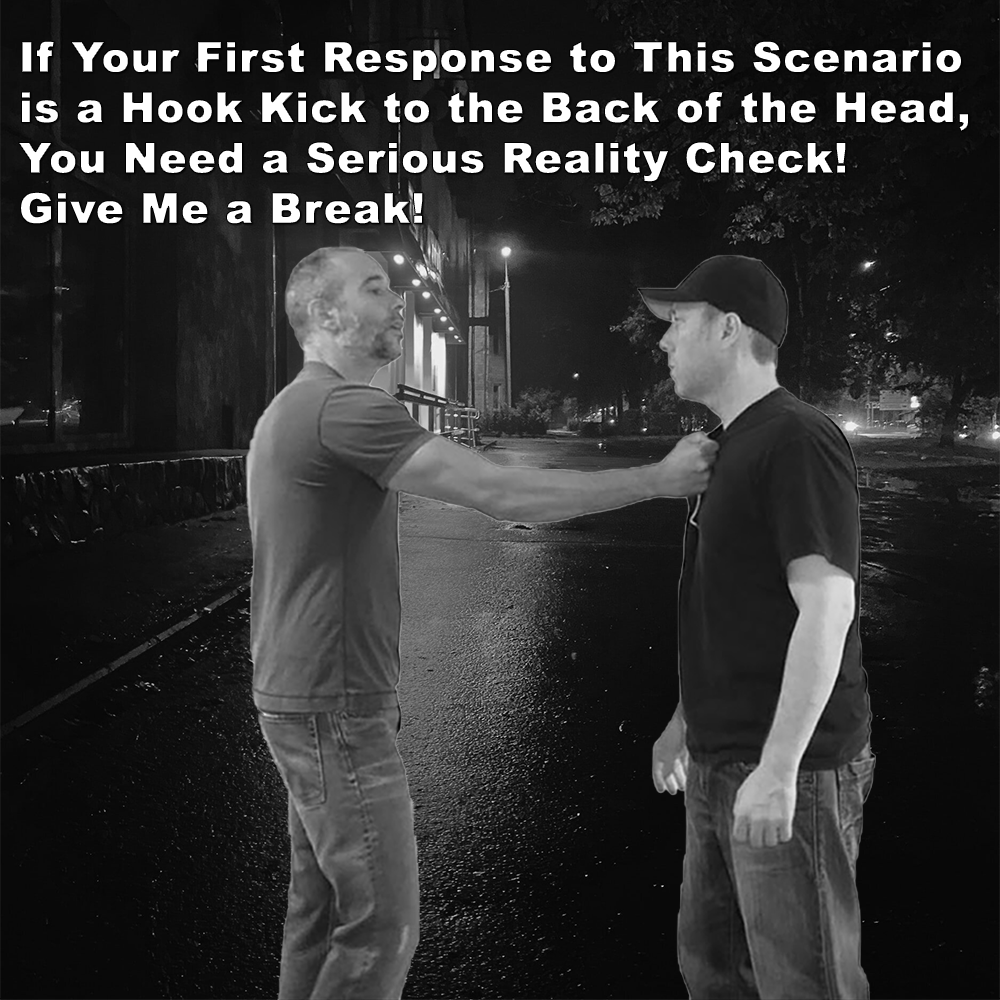
If Your First Response to This Scenario is a Hook Kick to the Back of the Head, You Need a Serious Reality Check!
Posted by ADAM CARTER on JUL 15, 2024

If Your First Response to This Scenario is a Hook Kick to the Back of the Head, You Need a Serious Reality Check!
(Approx 2 minute 20 second read)
Recently, I wrote an article in response to the use of ‘ura mawashi geri’ (hook kick) as a self-defense technique to a clothing grab. In response to the article I received a comment from the person suggesting its use, enthusiastically endorsing its effectiveness. “I have used it successfully in self-defense and tournaments”, he claimed. “I can show you the video”.
The irony lies in the word “tournaments.” Regardless of personal success in competitions, the question remains: why would anyone employ a technique with such potentially harmful consequences in a real-life self-defense situation?
I am sure most people would agree that this is the wrong technique.
The problems with this approach are many. For starters, a chaotic, high-stress confrontation is vastly different from a controlled tournament environment. In a real-world struggle, where the grab is merely an indication of something else to quickly follow, factors such as adrenaline, unexpected movements, weapons, and multiple assailants can all render even highly practiced individuals and techniques ineffective.
There is so much wrong with using this technique it beggars belief that anyone could suggest its effectiveness.
Why on earth would you want to be standing on one leg when an attacker is grabbing you?
Failure of this kick, which has a high percentage rate, can leave you vulnerable to further attacks, potentially leading to severe injuries.
The commenter’s father, a renowned karate-ka, attempted to justify the use of this kick by suggesting lower kicks as an alternative.
Yes, of course there is an alternative, and this should have been shown first!
However, this oversimplifies the complexities of self-defense. Each situation demands a tailored response based on factors like the attacker’s size, strength, the environment and so much more. A blanket recommendation to “kick low” is irresponsible and demonstrates a fundamental misunderstanding of real-world violence.
It’s disheartening to see accomplished karate-ka promoting such impractical and potentially dangerous techniques.
Their insistence on the efficacy of tournament-honed moves suggests a detachment from the realities of self-defense. By teaching students these techniques, they are not only doing them a disservice but also contributing to the misconception that traditional karate is ineffective in such scenarios.
Many young students often idolize their instructors, believing them to be invincible. This is a dangerous illusion. When these respected figures promote unrealistic expectations, they put their students at risk.
It is crucial to remember that martial arts are practical tools, not magic. Their effectiveness relies on context, the practitioner’s skill, and understanding human behavior under stress. My five decades of experience have taught me the importance of context-specific training with techniques that are simple, effective, and executable under pressure for everyone not just a select few.
It’s a tragedy that some highly regarded karate-ka contribute to the perception of karate as ineffective. Their focus on tournament-oriented techniques undermines the true purpose of these disciplines: self-preservation.
Where the hell is common sense, practicality, and the safety of our students over ego and outdated ideals? Why do some experienced karate-ka insist on promoting impractical techniques? It is so frustrating.
It has to come down to their Ego, and perhaps their belief in their ‘superior’ style and their instructors reputations.
It is pure fantasy. These arrogant individuals should be ashamed of themselves.
![]() Photo Credit: With thanks to Nick Drossos (Note: the kick was not recommended by Nick)
Photo Credit: With thanks to Nick Drossos (Note: the kick was not recommended by Nick)
